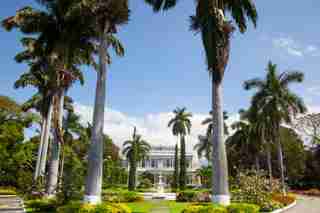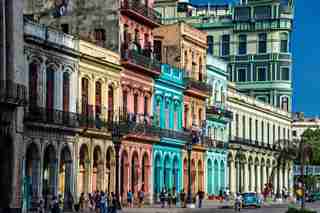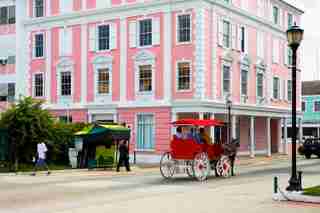Islands in the Caribbean are often equated with beaches, fruity drinks, and thatched-roof huts. But due to the region's different governing countries, which have—on some islands—shifted numerous times over the past century, architectural influences vary drastically, folding in Georgian, Art Deco, Dutch Colonial, and other styles. For history buffs, there are also many deep layers of historical context as to how these styles came to migrate across the ocean, dating back to colonial pasts as well as the abhorrent slave trade era. Whether you are sailing through on a cruise ship or private yacht—or looking for a Caribbean island for your next vacation—here are some definite stops for aesthetes. From the Neo-Gothic structures in Barbados’s capital city of Bridgetown to Moorish buildings in Old Havana and a contemporary performing-arts center in Trinidad, here’s where to go in search of architecture as the sun warms your face.

Kingston, Jamaica
Jamaica’s capital city is home to Devon House, an example of Jamaican Georgian architecture that was once the personal residence of the country’s first black millionaire, George Stiebel. The restored home, built in 1881, now operates as a museum as well as a National Heritage Site.

Old Havana, Havana, Cuba
Now that visitor restrictions have loosened—and cruise ships dock in Havana overnight—it’s time to check out Cuba. When you’re not being chauffeured in a 1950s Chevy convertible painted in a vivid hue, stroll through Old Havana where the streets are equally as colorful and filled with examples of Cuban Baroque and Moorish buildings, a result of its founding by Spain in 1519.

Nassau, Bahamas
You know the Bahamas for its pink-sand beaches, but what about pink architecture? Colonial-style buildings shine in varying shades of pink, including the flamingo-pink ones built in Parliament Square in 1815 by the Loyalists in the country’s capital city.
Guadeloupe
Reconstructed in 1876, Cathédrale de St-Pierre et St-Paul is in the center of Pointe-à-Pitre, this French-speaking country’s largest city. Self-guided tours are offered daily inside this church with its bright-yellow exterior.
San Juan, Puerto Rico
A popular Caribbean jaunt because you don’t need a passport, Puerto Rico’s largest city entertains a mix of tourists and architectural enthusiasts in Old San Juan with its cobblestone streets. Cathedral of San Juan Bautista—the second oldest cathedral in the Americas—is a great example of Neoclassical architecture; it's just a block from the water.
Willemstad, Curaçao
Often photographed, the Dutch Colonial homes on Willemstad’s waterfront are a rainbow of color, but the residential pockets in this capital city are just as vibrant. Colonized by the Netherlands in 1634, historic Willemstad became a UNESCO World Heritage Site in 1997.
Bridgetown, Barbados
The downtown of this capital port city has UNESCO World Heritage Site status, in part due to neo-Gothic architecture like the Parliament Buildings in Bridgetown, Barbados. Built during the 1870s, they are now UNESCO-protected properties.
Oranjestad, Aruba
Given that the island was under Dutch control for nearly two centuries (beginning in 1636), Dutch Colonial style is abundant in Aruba’s capital (and largest) city. This includes Royal Plaza Mall’s pastel-pink exterior, with its trio of dormers, sky-blue window canopies, and ornate white trim.
Fort de France, Martinique
Named for Victor Schœlcher, a Frenchman who fought for the end of slavery in the French Caribbean nations of Martinique and Guadeloupe, this stunning public library (Schœlcher Library) was built in 1887. The mish-mash of architectural styles was from the hands of architect Henri Picq, who used concrete, wood, and wrought iron. Within the library is Schoelcher’s private collection of around 9,000 books.
La Romana, Dominican Republic
This 5,000-seat open-air Altos de Chavón amphitheater—designed by Italian architect Roberto Copa—looks like it belongs in Athens but was actually completed just before a 1982 concert by Frank Sinatra. Adjacent to the amphitheater is a replica 16th-century Mediterranean village with shops and restaurants.
St. Lucia
Within Pigeon Island National Park—near Rodney Bay on a 44-acre island—are preserved ruins from military battles between the French and British during the 1770s. St. Lucia declared this site a national park in 1979. Tropical flowers and plants, along with white-sand beaches, contribute to the park’s gorgeous setting.
Port of Spain, Trinidad
Celebrating its 10th anniversary this year, the eye-catching (especially at night when it’s all lit up) National Academy for the Performing Arts includes a 1,500-seat theater (hosting carnival-type shows, plays, and traveling musicians), a hotel, and a sound lab.
Nevis
Dating back to 1643, St. Thomas is the Caribbean’s oldest Anglican church. Find the parish up on a hill, just past its cemetery, overlooking St. Kitts and three miles north of Charlestown, which is the island’s current capital. (In earlier years, Jamestown served as the capital before it was all but destroyed in a 1690 tsunami.)
Mémorial ACTe, Pointe-à-Pitre, Guadelupe
Unveiled in 2015 as a new memorial for the slave trade that took place in this French territory, Memorial ACTe (Caribbean Centre of Expression and Memory of Slavery and the Slave Trade) is on the site of a former sugar factory. Berthelot/Mocka-Célestine, an architecture firm based in Guadeloupe, designed the building, which is part of UNESCO’s Slave Route Project.

Leave a Reply